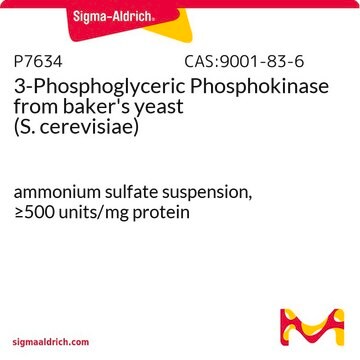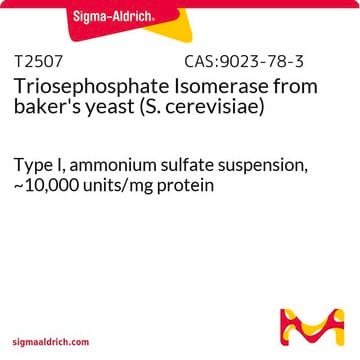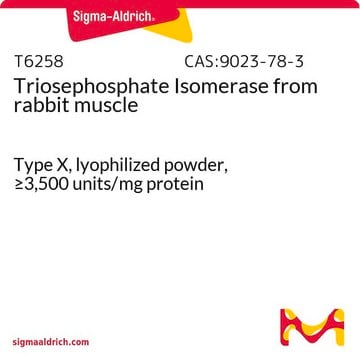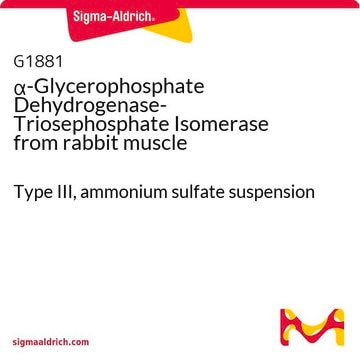R0878
D-Ribulose 1,5-bisphosphate sodium salt hydrate
≥90% (TLC)
Sinonimo/i:
D-erythro-2-Pentulose, 1,5-bis(dihydrogen phosphate), D-Ribulose 1,5-diphosphate, RuDP
About This Item
Prodotti consigliati
Origine biologica
synthetic (inorganic)
Livello qualitativo
Saggio
≥90% (TLC)
Stato
powder
Impurezze
≤16% water (Karl Fischer)
Colore
white
Solubilità
water: ~50 g/L
Cationi in tracce
Na: 17.1-24.6% (dry basis)
Temperatura di conservazione
−20°C
Stringa SMILE
[P](=O)(OC[C@@H](O)[C@@H](O)C(=O)CO[P](=O)(O)O)(O)O
InChI
1S/C5H12O11P2/c6-3(1-15-17(9,10)11)5(8)4(7)2-16-18(12,13)14/h3,5-6,8H,1-2H2,(H2,9,10,11)(H2,12,13,14)/t3-,5-/m1/s1
YAHZABJORDUQGO-NQXXGFSBSA-N
Cerchi prodotti simili? Visita Guida al confronto tra prodotti
Categorie correlate
Applicazioni
- Bio-Inspired Microreactors Continuously Synthesize Glucose Precursor from CO(2) with an Energy Conversion Efficiency 3.3 Times of Rice.: This study leverages D-Ribulose 1,5-bisphosphate sodium salt hydrate in bio-inspired microreactors to synthesize glucose precursors from CO₂. The approach demonstrates an energy conversion efficiency significantly higher than that of rice, highlighting its potential for efficient carbon fixation and bioengineering applications (Zhu et al., 2024).
- Designing Stacked Assembly of Type III Rubisco for CO₂ Fixation with Higher Efficiency.: The research utilizes D-Ribulose 1,5-bisphosphate sodium salt hydrate to enhance the efficiency of CO₂ fixation through the stacked assembly of Type III Rubisco. This innovative approach offers improvements in metabolic engineering for carbon capture and utilization (Zeng et al., 2022).
- Continuous artificial synthesis of glucose precursor using enzyme-immobilized microfluidic reactors.: This study explores the continuous synthesis of glucose precursors using microfluidic reactors with immobilized enzymes, including D-Ribulose 1,5-bisphosphate sodium salt hydrate. The technique demonstrates potential for scalable biochemical production processes (Zhu et al., 2019).
Azioni biochim/fisiol
Altre note
Codice della classe di stoccaggio
11 - Combustible Solids
Classe di pericolosità dell'acqua (WGK)
WGK 3
Punto d’infiammabilità (°F)
Not applicable
Punto d’infiammabilità (°C)
Not applicable
Dispositivi di protezione individuale
Eyeshields, Faceshields, Gloves, type P2 (EN 143) respirator cartridges
Scegli una delle versioni più recenti:
Certificati d'analisi (COA)
Non trovi la versione di tuo interesse?
Se hai bisogno di una versione specifica, puoi cercare il certificato tramite il numero di lotto.
Possiedi già questo prodotto?
I documenti relativi ai prodotti acquistati recentemente sono disponibili nell’Archivio dei documenti.
I clienti hanno visto anche
Active Filters
Il team dei nostri ricercatori vanta grande esperienza in tutte le aree della ricerca quali Life Science, scienza dei materiali, sintesi chimica, cromatografia, discipline analitiche, ecc..
Contatta l'Assistenza Tecnica.














